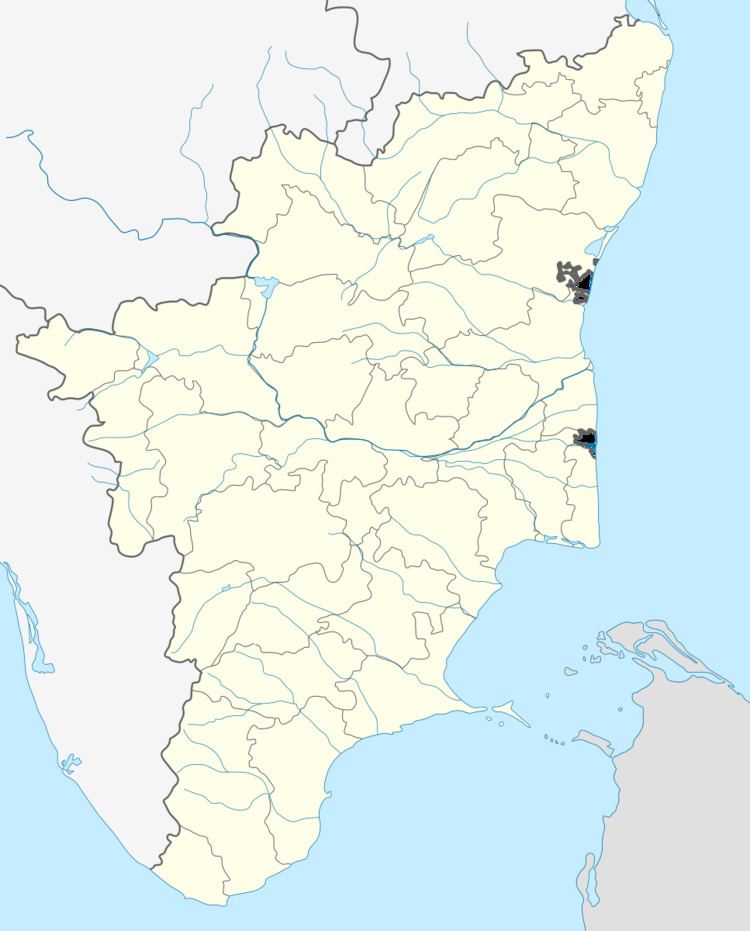Country India Primary deity Sooryanar(Sun) Phone 0435 247 2349 Architectural style Dravidian architecture | State/province Tamil Nadu Architectural styles Dravidian architecture District Thanjavur district Locale Maruthuvakudi | |
 | ||
Address Thirumangalakudi P.O, Thanjavur D.T, Thiruvidaimaruthur, Tamil Nadu 612102 Similar Prananadeswarar Temple, Swetharanyeswarar Temple, Kumbakonam Brahma Temple | ||
Suryanar Kovil (also called Suryanar Temple) is a Hindu temple dedicated to the deity Hindu Sun-God, located in Suryanar Kovil, a village near the South Indian own of Kumbakonam in Tamil Nadu, India. The presiding deity is Suriyanar, the Sun and his consorts Ushadevi and Pratyusha Devi. The temple also has separate shrines for the other eight planetary deities. The temple is considered one of the nine Navagraha temples in Tamil Nadu. The temple is one of the few historic temples dedicated to Sun god and is also the only temple in Tamil Nadu which has shrines for all the planetary deities.
Contents
The present masonry structure was built during the reign of Kulottunga Choladeva (AD 1060-1118) in the 11th century with later additions from the Vijayanagar period. Constructed in the Dravidian style of architecture, the temple has a five-tiered rajagopuram, the gateway tower and a granite wall enclosing all the shrines of the temple.
It is believed that the planetary deities were cursed by Brahma to dwell in Vellurukku Vanam, the white wild flower jungle and were blessed by Shiva to make it their abode to devotees. The temple has six daily rituals at various times from 5:30 a.m. to 9 p.m., and two yearly festivals on its calendar. The temple is maintained and administered by the Hindu Religious and Charitable Endowments Department of the Government of Tamil Nadu.
Suryanar kovil tanjore tamil nadu
Legend
As per Hindu legend, Sage Kalava was suffering from serious ailments along with leprosy. He prayed to the Navagrahas, the nine planet deities. The planets were pleased by his devotion and offered cure to the sage. Brahma, the Hindu god of creation, was angered as he felt that the planets have no powers to provide boons to humans. He cursed the nine planets to suffer from leprosy and were sent down to earth in Vellurukku Vanam, the white wild flower jungle. The planets prayed to Shiva to relieve them off the curse. Shiva appeared to them and said that the place belonged to them and they would have to grace the devotees worshipping them from the place. This is the only temple where there are separate shrines for each of the planet deities.
History
It is stated in one of the inscriptions found in the temple that it was built in the reign of Kulottunga Choladeva (AD 1060-1118) and was called Kulottungachola-Marttandalaya. The current granite shrine is believed to have been built by the Srivijaya King.He is the native of srivijayam it is near by Indonesia. In modern times, the temple is maintained and administered by the Hindu Religious and Charitable Endowments Department of the Government of Tamil Nadu. The temple is mentioned in the songs of Muthuswami Dikshitar, who has composed a song starting with "Suryamurthe" in Saurashatra ragam.
Architecture
Sooriyanar Temple is located to the East of Kumbakonam, 2 km (1.2 mi) from Aduthurai and the Kumbakonam - Mayiladuthurai road. The temple has direct connectivity from lower Anicut and Thiruppanandal. The temple has a rectangular plan with compound walls, pierced by a five-tiered raja gopuram (entrance tower). The central shrine is of Surya, the Sun God, is built on an elevated structure. The central shrine houses the image of Surya and his consorts Usha and Chhaya. The hall leading to the central shrine has images of Viswanathar, Visalakshi, Nataraja, Sivakami, Vinayagar and Murugan. On the axial line in front of the central shrine, there is an image of Guru (Jupiter), one of the planetary deities. There are separate shrines for all the other seven planet deities namely Budha (Mercury), Shani (Saturn), Sukran (Venus), Soma (Moon), Angaragan (Mercury), Rahu and Ketu. All the other eight shrines of the Navagrahas are arranged facing the shrine of Suryanar. Guru is depicted performing pooja to Shiva.
Worship and festivals
The temple priests perform the pooja (rituals) during festivals and on a daily basis. Like other Shiva temples of Tamil Nadu, the priests belong to the Shaivaite community, a Brahmin sub-caste. The temple rituals are performed six times a day; Ushathkalam at 5:30 a.m., Kalasanthi at 8:00 a.m., Uchikalam at 10:00 a.m., Sayarakshai at 6:00 p.m., Irandamkalam at 8:00 p.m. and Ardha Jamam at 10:00 p.m. Each ritual comprises four steps: abhisheka (sacred bath), alangaram (decoration), neivethanam (food offering) and deepa aradanai (waving of lamps) for Surya, Usha and Chhaya. The worship is held amidst music with nagaswaram (pipe instrument) and tavil (percussion instrument), religious instructions in the Vedas read by priests and prostration by worshippers in front of the temple mast. There are weekly rituals like somavaram and sukravaram, fortnightly rituals like pradosham and monthly festivals like amavasai (new moon day), kiruthigai, pournami (full moon day) and sathurthi.
The temple is one of the nine Navagraha temples of Tamil Nadu and is a part of the popular Navagraha pilgrimage in Tamil Nadu. The planets are believed to influence the horoscope computed based on time of one's birth and subsequently influence the course of life. Each of the planets are believed to move from a star to another during a predefined period and thus sway over an individual's fortunes. The Navagrahas, as per Hindu customs, are believed to provide both good and bad effects for any individual and the bad effects are mitigated by prayers. As in other Navagraha temples, the common worship practises of the devotees include offering of cloth, grains, flowers and jewels specific to the planet deity. Lighting a set of lamps is also commonly followed in the temple.
